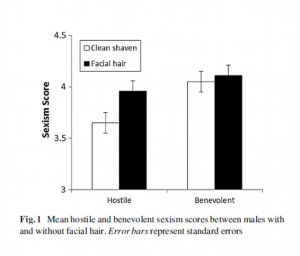To find the mind’s construction near the face
Q: This Herald photo caption says “Men with facial hair showed much higher levels of hostile sexism, the study found.” Did it?
A: No.
Q: Ok, how about the introduction “Bearded men will just have to take it on the chin – they are, apparently, more sexist.”?
A: Not really.
Q: <sigh> Was this mice again?
A: No, there aren’t good animal models for these variables, as far as I know. It was people.
Q: University students?
A: No, that’s so five years ago. It was a survey on Amazon’s Mechanical Turk, of men from the US and India.
Q: A representative survey?
A: Well, they paid people US$0.25 to participate, so I’m guessing maybe not. It’s probably better than using an undergraduate psychology class, though.
Q: And they measured sexism and beards over the internet?
A: The sexism was a standard questionnaire, so I think we should accept it. The participants were shown a set of facial hair images and asked to pick what their facial hair looked like. Probably ok, too.
Q: And men with beards were the most sexist?
A: No, men with moustaches, goatees, or soul patches.
Q: Then men with beards?
A: Then ‘light beards’, then light and heavy stubble, then heavy beards, then clean-shaven, then light medium beards.
Q: So it’s not primarily beards, it’s more other sorts of facial hair?
A: That’s what the study suggests
Q: Just like the photo caption?
A: Up to a point. “Much higher” is pushing it.
Q: How much higher?
A: About a third of a point, on a six point scale. About 1.5% of the variation between men could be predicted by their facial hair.
Q: Is there a bar chart, perhaps cut off at some non-zero value?
A: You’ve been reading the Daily Mail, haven’t you? Yes, there is:
Q: That’s not a very big difference, is it?
A: No
Q: So some men with facial hair are probably ok?
A: Probably.
Thomas Lumley (@tslumley) is Professor of Biostatistics at the University of Auckland. His research interests include semiparametric models, survey sampling, statistical computing, foundations of statistics, and whatever methodological problems his medical collaborators come up with. He also blogs at Biased and Inefficient See all posts by Thomas Lumley »
